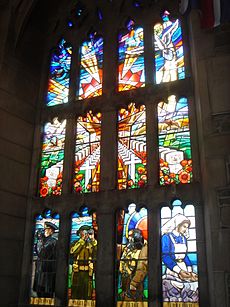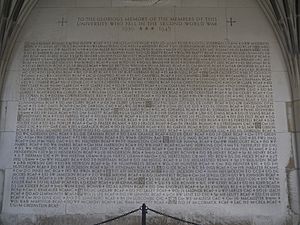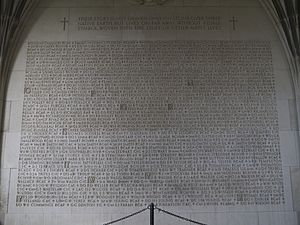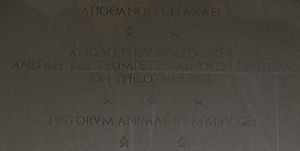Soldiers' Tower facts for kids
Quick facts for kids Soldiers' Tower |
|
|---|---|
| Canada | |
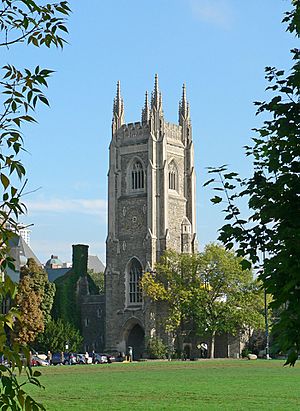
Soldiers' Tower seen from the northwest on the university's Back Campus lawn
|
|
| For members of the university who served in the World Wars | |
| Unveiled | 1924 |
| Location | University of Toronto near Toronto, Ontario, Canada
|
| Designed by | Henry Sproatt and Ernest Ross Rolph |
|
names of alumni lost in the Great War (1914–18) and in the Second World War (1939–45).
|
|
The Soldiers' Tower is a special bell and clock tower at the University of Toronto. It was built to remember students and staff from the university who served in the World Wars. The tower was designed by architects Henry Sproatt and Ernest Ross Rolph. It stands very tall at 143 feet (43.6 meters). Inside, it holds a carillon, which is like a giant musical instrument made of 51 bells. The University of Toronto is the only university in Canada that has a working carillon.
Contents
Building the Tower: A Look at its History
After World War I, also known as the Great War, people who used to go to the university (called alumni) raised money to build this tower. They wanted it to be a memorial to honor those who served. The first stone of the tower was placed in 1919 by Victor Cavendish, 9th Duke of Devonshire. He was the Governor General of Canada at that time.
The tower was finished in 1924. The names of those who died in World War I (1914–1918) are carved into a stone screen near the tower's base. Later, the names of those who died in World War II (1939–1945) were carved inside the tower's stone archway.
The Bells of Soldiers' Tower
In 1927, the tower got its clock and its first 23 bells for the carillon. These were bought from a famous British company called Gillett & Johnston. This company also made the bells for the Peace Tower on Parliament Hill in Ottawa.
More bells were added in 1952 to remember World War II. In 1976, these bells were replaced, and even more bells were added. The carillon now has 51 bells, made by a company called Petit & Fritsen. These bells range in weight from small ones (23 pounds) to a very large one (4 tons!).
The bells play music on special days. These include graduation ceremonies, reunions, homecoming events, and Remembrance Day. People from the university and the public can also enjoy regular bell concerts. Every year around November 11th, Remembrance Day ceremonies are held at the tower. People lay wreaths to honor the university's alumni who died in World War I and World War II.
Inside the Tower: Memorials and Art
The tower has a beautiful stained-glass window with 12 panels. Part of this window shows pictures inspired by the famous poem "In Flanders Fields" by John McCrae. There are also 8 smaller stained-glass windows. These show men and women from the armed forces during wartime. All these windows remember the University of Toronto members who served in the First and Second World Wars.
Inside the tower, there is also a museum. It displays a collection of medals, special memorial books, pictures, and flags from that time. Another stained-glass window remembers three students who died in the Fenian Raids, which were conflicts in the 1860s. High on the wall of the Memorial Room, there are stone carvings for each of the 51 bells. These carvings also remember individuals from the University of Toronto who died in World War I.
Messages Carved in Stone: The Inscriptions
The Soldiers' Tower has special messages carved into its stone panels. These are called inscriptions.
One inscription for World War I says:
To the glorious memory
of members of this University
who fell in the Great War
1914–1918
This means it honors the brave people from the university who died in the war.
Another message from World War I encourages people to be brave and protect their freedom:
Take these men for your ensamples
like them remember that prosperity can be only for the free
that freedom is the sure possession of those alone
who have the courage to defend it.
For World War II, an inscription says:
To the glorious memory of the members of this
University who fell in the Second World War
1939–1945
This also honors those from the university who died in the Second World War.
Another message for World War II talks about how their stories live on:
Their story is not graven only in stone over their
native earth, but lives on far away, without visible
symbol, woven into the stuff of other men's lives.
This means their bravery and sacrifice are remembered not just on the tower, but also in the lives of others.
There are also two short quotes in ancient languages on the World War I panels. One means "Though dead, he still speaks." The other means "The souls of the just [are] in the hands of God." These quotes add a deeper, thoughtful meaning to the memorial.
The famous poem "In Flanders Field" is also connected to the tower. Its author, John McCrae, is among the list of those who died in World War I.


